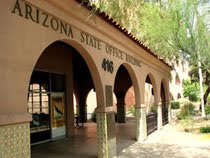
The Arizona Geological Survey, along with other state agencies, has been instructed to identify programs to permanently eliminate by January to meet another budget cut of 15% - 20%. This latest round is on top of a cumulative set of cuts amounting to about 30% over the past 15 months.
We need your advice and input on what programs will be shut down.
A difference between this round and previous cuts is that we have to identify state-supported programs to eliminate. There are no options for furloughs, salary reductions, or spreading cuts among programs. In addition, the cuts would not take effect until January 2010, halfway through the state fiscal year. So in reality we will have to cut 30-40% for the remainder of the year to meet a year-long target. These are permanent cuts, so it will really be a 30-40% reduction in our funding overall starting in January.
AZGS has weathered the cuts so far by increasing revenues from contracts and grants to subsidize state operations, judicious program reductions, and by not filling vacant positions. However, our fixed costs of rent, insurance, phones, etc have not been reduced and now consume a much larger percentage of the state budget. The administrative workload has not gone down, and in fact, we spend a lot more time dealing with budget cuts and keeping things functioning. As a result, the combined previous cuts of 30% with new cuts of 30-40% mean there could be little left but our fixed infrastructure costs and staff who are funded solely by external contracts and grants.
We are asking our stakeholders, our community of data and service users, and our partners, to let us know what are the most critical functions that we should try to preserve. In the next few days we will be releasing a list of all programs and the budgets assigned to them. We want your evaluation and prioritization of programs, services, products, and data. I'll be blogging, we'll post materials on the
AZGS website, and we'll be contacting many of you and your organizations directly.
The Governor's Office of Strategic Planning and Budget, has advised that we can keep a program running if we find non-state funds for it but the current plan is to sweep up a portion of the funds we raise outside as well. We expect that even some non-state funded services that we have kept running will go away as the state takes those funds from us. So, at this time, it appears that we will have even less funds to subsidize state functions than we do now.





































